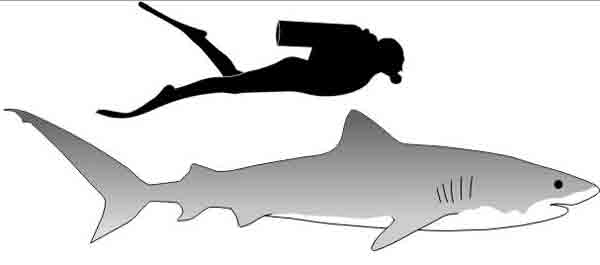Description
Origin : Indian Ocean (Yemen)
Size : mm 18-24
Tiger Shark Tooth Galeocerdo cuvier mm 18-24 Dogfishes Cartilaginous Fishes Chondrichthyes Selachians Elasmobranchs Carcharinidae.
Also available Shark Teeth Necklaces, single or in lots, at this link.
Syn. Carcharias fasciatus, Carcharias hemprichii, Galeocerdo arcticus, Galeocerdo obtusus, Galeocerdo rayneri, Galeocerdo tigrinus, Galeus cepedianus, Galeus maculatus, Squalus arcticus, Squalus cuvier.
The Tiger Shark (Galeocerdo cuvier, Péron & Lesueur, 1822) is a cartilagineous fish of the Carcharinidae family. If the extinct species are excluded, it is the only known specie currently living of Galeocerdo genus.
 This shark is mainly widespread in the coastal waters of tropical seas but is also located in all temperate ocean waters.
This shark is mainly widespread in the coastal waters of tropical seas but is also located in all temperate ocean waters.
It has also been reported in Italian waters and in the Mediterranean.
His slim, tapered body denotes the quality of an excellent swimmer; the head ends in a wide, rounded muzzle below which the wide mouth opens and is provided with teeth of the same shape, large, with sharp edges and serrated edges with a robust triangular tip bent sideways.
The tiger shark usually reaches 4 or 5 m in females, but it is possible to find male specimens that reach and exceed 6 m.
The color of the tiger shark varies according to age; in young people, it is dark, marked by numerous dark spots and transverse strokes, which, with age advancing, are increasingly attenuated to form a uniform brown-gray livery in adults. It weights 400 kg to 800 kg
Tiger sharks are eyewear and are reproduced by sharking live sharks, always placed in a high number (from 30 to over 50 per birth), unlike most in the Selachii.
Fast and powerful in the swim, tiger sharks hunt fishponds off the beach but are also at ease near the shores, sometimes even in the harbors and lagoons.
Predatory dolphins, small cetaceans, sea birds, races, fishes, sea turtles, cephalopod molluscs (also of considerable size), crustaceans and other sharks.
Swimming by the sea can also meet the marine crocodile. In these cases it is difficult to tell who the predator is and who prey it, it all depends on the size and physical condition of the two animals. However, it is documented that the two species devote themselves to each other.
This species has a remarkable economic significance because its oil is extracted from its liver, which, amongst the various uses, is used in human therapeutics for its qualities similar to those of cod liver oil. In addition, the leather, suitably tanned, provides a good leather. Its meats are edible and the fins are considered a delicacy by the coastal populations of the Indian Ocean and the Southwestern Pacific Ocean. It is a dangerous species for man, probably the second, after the Leech Shark; many attacks along the coasts of the hot seas are attributable to this species and not to the white shark, which, although cosmopolitan, is much more rare.



